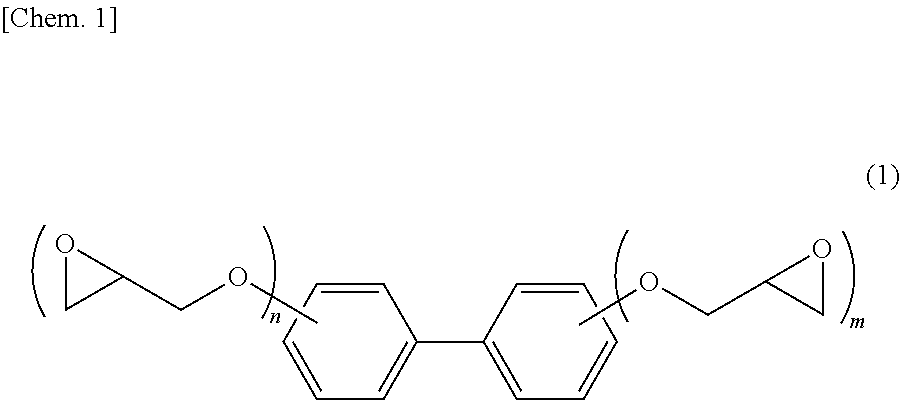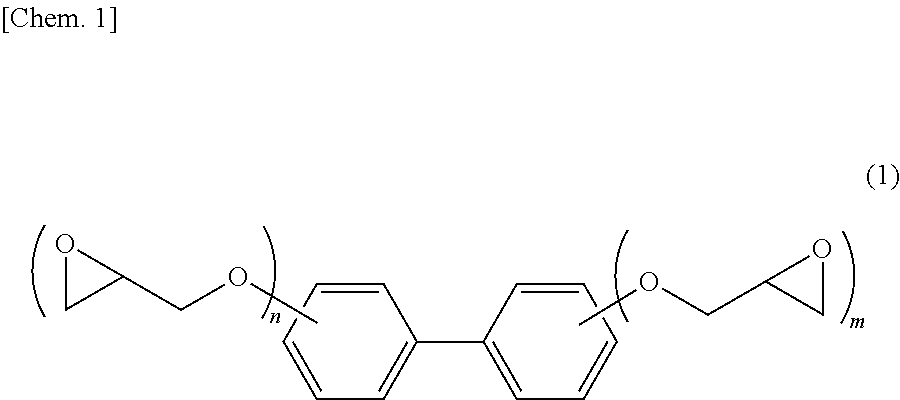Epoxy resin composition for electronic material, cured product thereof and electronic member
a technology of epoxy resin and electronic material, which is applied in the direction of adhesive additives, non-macromolecular adhesive additives, dielectric characteristics, etc., can solve the problems of limited enhancing thermal conductivity, difficult to use epoxy resin for electronic material, and epoxy resin having a mesogenic structure, etc., to achieve good solvent solubility, excellent heat resistance, and low viscosity
- Summary
- Abstract
- Description
- Claims
- Application Information
AI Technical Summary
Benefits of technology
Problems solved by technology
Method used
Image
Examples
synthesis example 1
Synthesis of 2,4,4′-triglycidyloxybiphenyl
[0133]In a flask equipped with a thermometer, a dropping funnel, a condenser tube, and a stirrer, while being purged with nitrogen gas, 43 g of 2,4,4′-trihydroxybiphenyl, 295 g of epichlorohydrin, and 103 g of n-butanol were charged and dissolved. After the temperature was raised to 40° C., 53 g of a 48% by mass sodium hydroxide aqueous solution was added over 8 hours. The temperature was then further raised to 50° C., and the mixture was allowed to react for further 1 hour. After the completion of the reaction, 83 g of water was added, the mixture was allowed to stand, and then the lower layer was disposed. After that, unreacted epichlorohydrin was removed by distillation at 150° C. under reduced pressure. To the obtained crude epoxy resin, 118 g of methyl isobutyl ketone was added to dissolve the epoxy resin. To the solution, 67 g of a 10% by mass sodium hydroxide aqueous solution was further added, the mixture was allowed to react at 80° ...
synthesis example 2
Synthesis of 3,4′,5-triglycidyloxybiphenyl
[0134]In a flask equipped with a thermometer, a dropping funnel, a condenser tube, and a stirrer, while being purged with nitrogen gas, 43 g of 3,4′,5-trihydroxybiphenyl, 295 g of epichlorohydrin, and 103 g of n-butanol were charged and dissolved. After the temperature was raised to 40° C., 53 g of a 48% by mass sodium hydroxide aqueous solution was added over 8 hours, then the temperature was further raised to 50° C., and the mixture was allowed to react for further 1 hour. After the completion of the reaction, 83 g of water was added, the mixture was allowed to stand, and then the lower layer was disposed. After that, unreacted epichlorohydrin was removed by distillation at 150° C. under reduced pressure. To the obtained crude epoxy resin, 118 g of methyl isobutyl ketone was added to dissolve the epoxy resin. To the solution, 67 g of a 10% by mass sodium hydroxide aqueous solution was further added, the mixture was allowed to react at 80° ...
synthesis example 3
Synthesis of 3,3′,5,5′-tetraglycidyloxybiphenyl
[0135]In a flask equipped with a thermometer, a dropping funnel, a condenser tube, and a stirrer, while being purged with nitrogen gas, 35 g of 3,3′,5,5′-tetrahydroxybiphenyl, 297 g of epichlorohydrin, 104 g of n-butanol were charged and dissolved. After the temperature was raised to 40° C., 53 g of a 48% sodium hydroxide aqueous solution was added over 8 hours, the temperature was then further raised to 50° C. and the mixture was further reacted for 1 hour. After the completion of the reaction, 84 g of water was added, the mixture was allowed to stand, and then the lower layer was disposed. After that, unreacted epichlorohydrin was removed by distillation at 150° C. under reduced pressure. To the obtained crude epoxy resin, 106 g of methyl isobutyl ketone was added to dissolve the epoxy resin. To the solution, 67 g of a 10 mass % sodium hydroxide aqueous solution was further added, the mixture was allowed to react at 80° C. for 2 hours...
PUM
| Property | Measurement | Unit |
|---|---|---|
| thermal conductivity | aaaaa | aaaaa |
| temperature | aaaaa | aaaaa |
| particle size | aaaaa | aaaaa |
Abstract
Description
Claims
Application Information
 Login to View More
Login to View More - R&D
- Intellectual Property
- Life Sciences
- Materials
- Tech Scout
- Unparalleled Data Quality
- Higher Quality Content
- 60% Fewer Hallucinations
Browse by: Latest US Patents, China's latest patents, Technical Efficacy Thesaurus, Application Domain, Technology Topic, Popular Technical Reports.
© 2025 PatSnap. All rights reserved.Legal|Privacy policy|Modern Slavery Act Transparency Statement|Sitemap|About US| Contact US: help@patsnap.com


